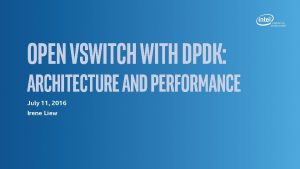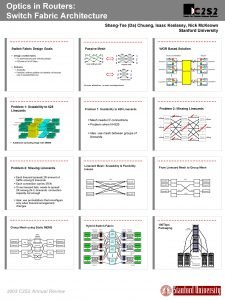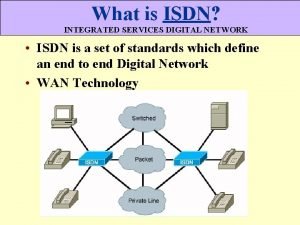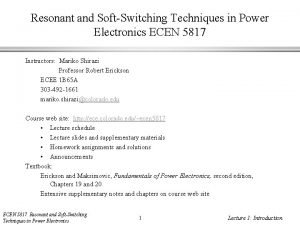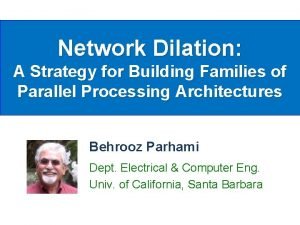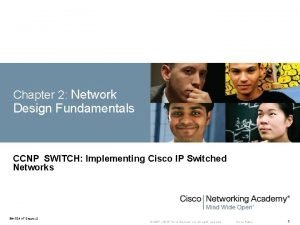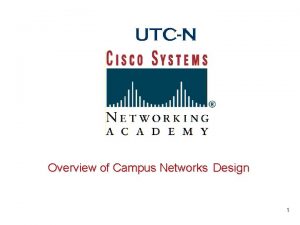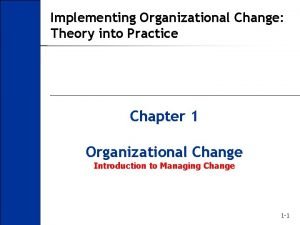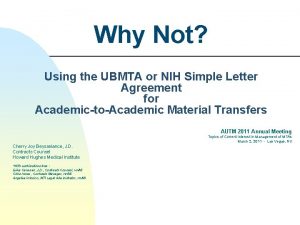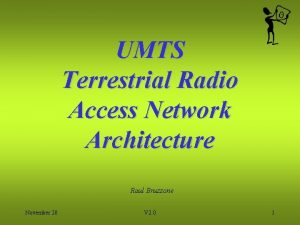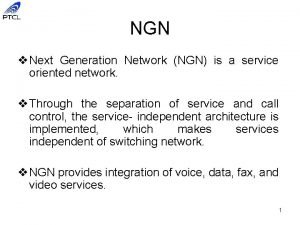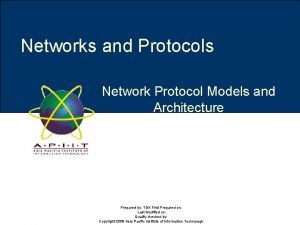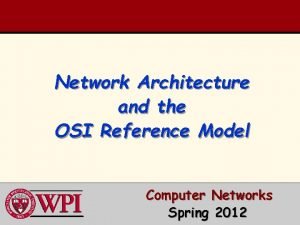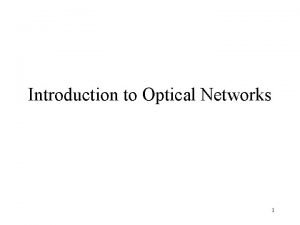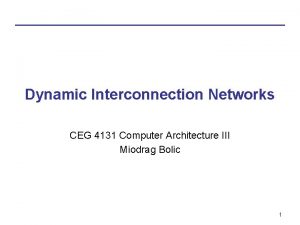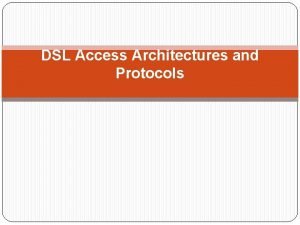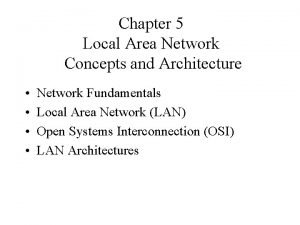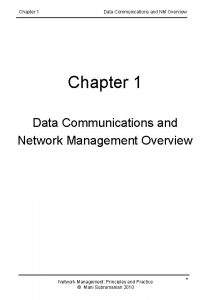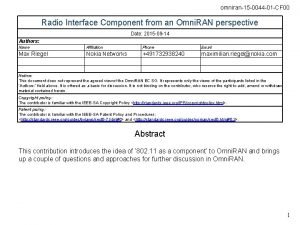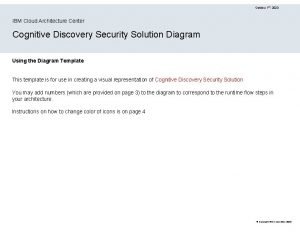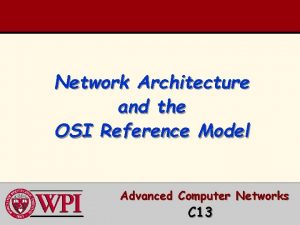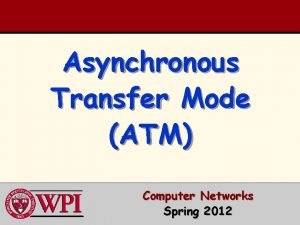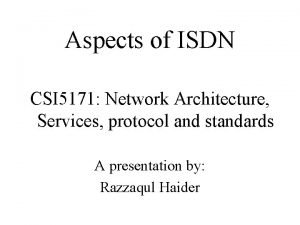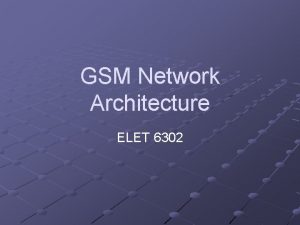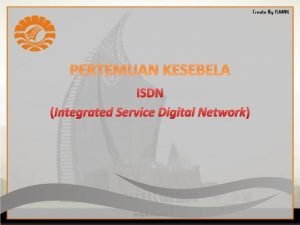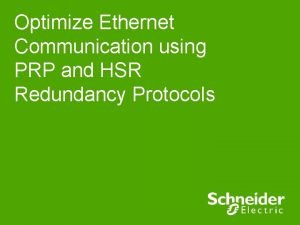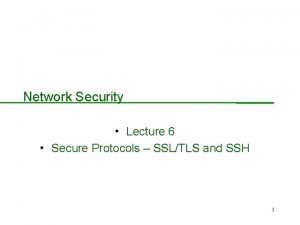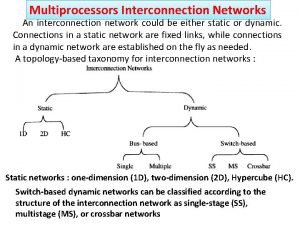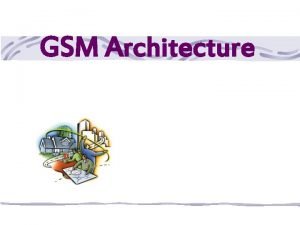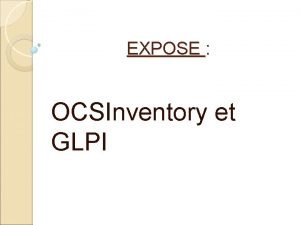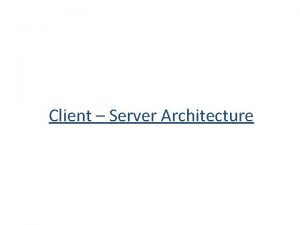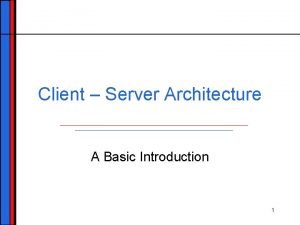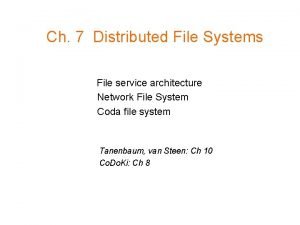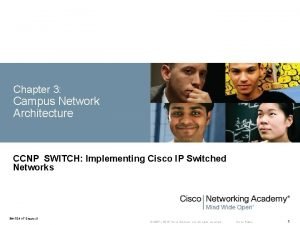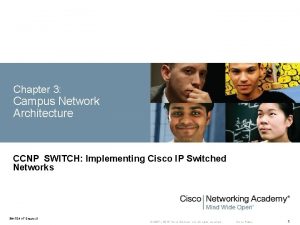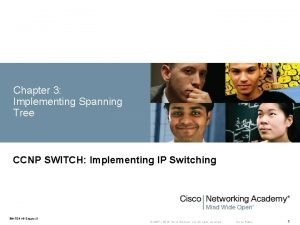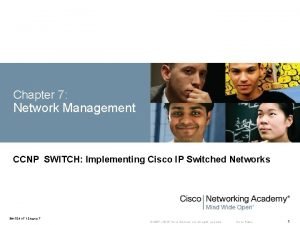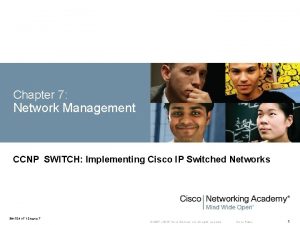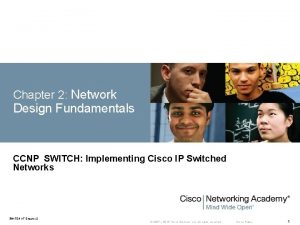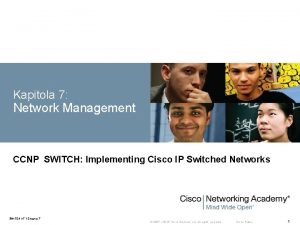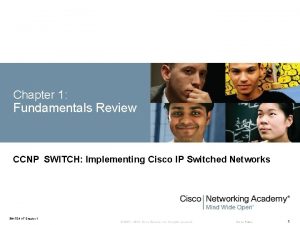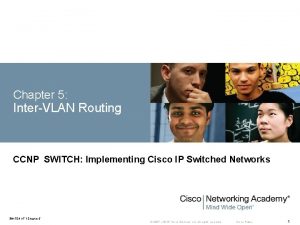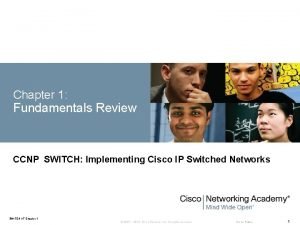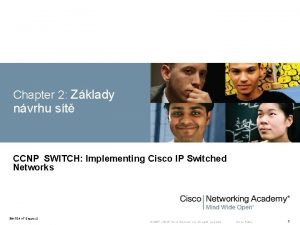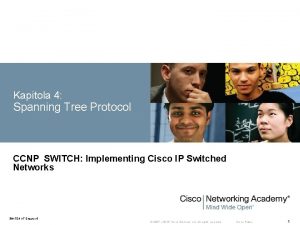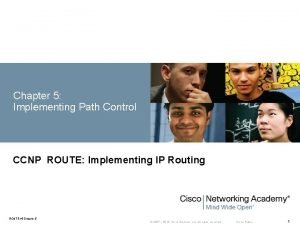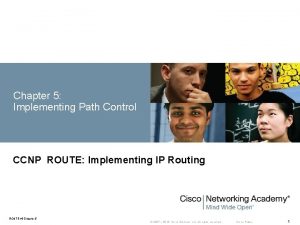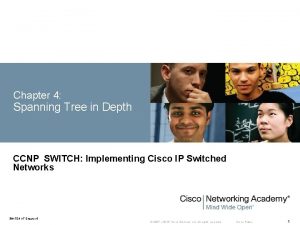Chapter 3 Campus Network Architecture CCNP SWITCH Implementing























































































- Slides: 87

Chapter 3: Campus Network Architecture CCNP SWITCH: Implementing Cisco IP Switched Networks SWITCH v 7 Chapter 3 © 2007 – 2016, Cisco Systems, Inc. All rights reserved. Cisco Public 1

Chapter 3 Objectives § Implementing VLANs and trunks in campus switched architecture § Understanding the concept of VTP and its limitation and configurations § Implementing and configuring Ether. Channel Chapter 3 © 2007 – 2016, Cisco Systems, Inc. All rights reserved. Cisco Public 2

Implementing VLANs and Trunks in Campus Environment Chapter 3 © 2007 – 2016, Cisco Systems, Inc. All rights reserved. Cisco Public 3

Implementing VLANs and Trunks in Campus Environment § Within the switched internetwork, VLANs provide segmentation and organizational flexibility. § VLANs help administrators to have the end node or workstations group that are segmented logically by functions, project teams, and applications, without regard to the physical location of the users. § VLANs allow you to implement access and security policies to particular groups of users and limit the broadcast domain. § The voice VLAN feature enables access ports to carry IP voice traffic from an IP phone. Because the sound quality of an IP phone call can deteriorate if the data is unevenly sent, the switch supports quality of service (Qo. S). Chapter 3 © 2007 – 2016, Cisco Systems, Inc. All rights reserved. Cisco Public 4

VLAN Overview Chapter 3 © 2007 – 2016, Cisco Systems, Inc. All rights reserved. Cisco Public 5

VLAN Segmentation § Larger flat networks generally consist of many end devices in which broadcasts and unknown unicast packets are flooded on all ports in the network. § One advantage of using VLANs is the capability to segment the Layer 2 broadcast domain. All devices in a VLAN are members of the same broadcast domain. If an end device transmits a Layer 2 broadcast, all other members of the VLAN receive the broadcast. § Switches filter the broadcast from all the ports or devices that are not part of the same VLAN. § In a campus design, a network administrator can design a campus network with one of two models: • End-to-End VLANs • Local VLANs. § Each model has its own advantages and disadvantages. Chapter 3 © 2007 – 2016, Cisco Systems, Inc. All rights reserved. Cisco Public 6

End-to-End VLANs § End-to-End VLAN refers to a single VLAN that is associated with switch ports widely dispersed throughout an enterprise network on multiple switches. Chapter 3 © 2007 – 2016, Cisco Systems, Inc. All rights reserved. Cisco Public 7

End-to-End VLAN Model Characteristics § Each VLAN is dispersed geographically throughout the network. § Users are grouped into each VLAN regardless of the physical location. § As a user moves throughout a campus, the VLAN membership of that user remains the same, regardless of the physical switch to which this user attaches. § Users are typically associated with a given VLAN for network management reasons. This is why they are kept in the same VLAN, therefore the same group, as they move through the campus. § All devices on a given VLAN typically have addresses on the same IP subnet. § Switches commonly operate in a server/client VTP mode. Chapter 3 © 2007 – 2016, Cisco Systems, Inc. All rights reserved. Cisco Public 8

Local VLANs § In a local VLAN model, all users of a set of geographically common switches are grouped into a single VLAN, regardless of the organizational function of those users. Chapter 3 © 2007 – 2016, Cisco Systems, Inc. All rights reserved. Cisco Public 9

Local VLAN Model Characteristics § The network administrator should create local VLANs with physical boundaries in mind rather than the job functions of the users on the end devices. § Generally, local VLANs exist between the access and distribution levels. § Traffic from a local VLAN is routed at the distribution and core levels to reach destinations on other networks. § Configure the VTP mode in transparent mode because VLANs on a given access switch should not be advertised to all other switches in the network, nor do they need to be manually created in any other switch VLAN databases. § A network that consists entirely of local VLANs can benefit from increased convergence times offered via routing protocols, instead of a spanning tree for Layer 2 networks. It is usually recommended to have one to three VLANs per access layer switch. Chapter 3 © 2007 – 2016, Cisco Systems, Inc. All rights reserved. Cisco Public 10

Comparison of End-to-End VLANs and Local VLANs Reasons for implementing the end-to-end design: § Grouping users • Users can be grouped on a common IP segment, even though they are geographically dispersed. § Security • A VLAN can contain resources that should not be accessible to all users on the network, or there might be a reason to confine certain traffic to a particular VLAN. § Applying quality of service (Qo. S) • Traffic can be a higher- or lower-access priority to network resources from a given VLAN. Chapter 3 © 2007 – 2016, Cisco Systems, Inc. All rights reserved. Cisco Public 11

Comparison of End-to-End VLANs and Local VLANs Reasons for implementing the end-to-end design (cont. ): § Routing avoidance • If much of the VLAN user traffic is destined for devices on that same VLAN. § Special-purpose VLAN • Sometimes a VLAN is provisioned to carry a single type of traffic that must be dispersed throughout the campus (for example, multicast, voice, or visitor VLANs). § Poor design • For no clear purpose, users are placed in VLANs that span the campus or even span WANs. Sometimes when a network is already configured and running, organizations are hesitant to improve the design because of downtime or other political reasons. Chapter 3 © 2007 – 2016, Cisco Systems, Inc. All rights reserved. Cisco Public 12

Comparison of End-to-End VLANs and Local VLANs § Reasons for implementing the Local Vlan design: § Deterministic traffic flow • The simple layout provides a predictable Layer 2 and Layer 3 traffic path. § Active redundant paths • When implementing Per-VLAN Spanning Tree (PVST) or Multiple Spanning Tree (MST) because there is no loop, all links can be used to make use of the redundant paths. § High availability • Redundant paths exist at all infrastructure levels. § Finite failure domain • If VLANs are local to a switch block, and the number of devices on each VLAN is kept small, failures at Layer 2 are confined to a small subset of users. § Scalable design • Following the enterprise campus architecture design, new access switches can be easily incorporated, and new submodules can be added when necessary. Chapter 3 © 2007 – 2016, Cisco Systems, Inc. All rights reserved. Cisco Public 13

Comparison of End-to-End VLANs and Local VLANs End-to-End VLANs drawbacks: § Switch ports are provisioned for each user and associated with a given VLAN. Because users on an end-to-end VLAN can be anywhere in the network, all switches must be aware of that VLAN. This means that all switches carrying traffic for end-to-end VLANs are required to have those specific VLANs defined in each switch’s VLAN database. § Flooded traffic for the VLAN is, by default, passed to every switch even if it does not currently have any active ports in the particular end-to-end VLAN. § Troubleshooting devices on a campus with end-to-end VLANs can be challenging because the traffic for a single VLAN can traverse multiple switches in a large area of the campus, and that can easily cause potential spanning-tree problems. Chapter 3 © 2007 – 2016, Cisco Systems, Inc. All rights reserved. Cisco Public 14

Implementing a Trunk in a Campus Environment § A trunk is a point-to-point link that carries the traffic for multiple VLANs across a single physical link between the two switches or any two devices. § Trunking is used to extend Layer 2 operations across an entire network. Chapter 3 © 2007 – 2016, Cisco Systems, Inc. All rights reserved. Cisco Public 15

Trunking Protocols § A special protocol is used to carry multiple VLANs over a single link between two devices. There are two trunking technologies: § Inter-Switch Link (ISL): A Cisco proprietary trunking encapsulation § IEEE 802. 1 Q: An industry-standard trunking method Chapter 3 © 2007 – 2016, Cisco Systems, Inc. All rights reserved. Cisco Public 16

ISL Frame Chapter 3 © 2007 – 2016, Cisco Systems, Inc. All rights reserved. Cisco Public 17

802. 1 Q Frame Chapter 3 © 2007 – 2016, Cisco Systems, Inc. All rights reserved. Cisco Public 18

IEEE 802. 1 Q/802. 1 p advantages over ISL § 802. 1 Q has smaller frame overhead than ISL. As a result, 802. 1 Q is more efficient than ISL, especially in the case of small frames. 802. 1 Q overhead is 4 bytes, whereas ISL is 30 bytes. § 802. 1 Q is a widely supported industry standard protocol. § 802. 1 Q has the support for 802. 1 p fields for Qo. S. Chapter 3 © 2007 – 2016, Cisco Systems, Inc. All rights reserved. Cisco Public 19

802. 1 Q tag § Inserted 802. 1 Q tag (4 bytes, detailed here) • Ether. Type(TPID): Set to 0 x 8100 to specify that the 802. 1 Q tag follows. • PRI: 3 -bit 802. 1 p priority field. • CFI: Canonical Format Identifier is always set to 0 for Ethernet switches and to 1 for Token Ring-type networks. • VLAN ID: 12 -bit VLAN field. Of the 4096 possible VLAN IDs, the maximum number of possible VLAN configurations is 4094. A VLAN ID of 0 indicates priority frames, and value 4095 (FFF) is reserved. Chapter 3 © 2007 – 2016, Cisco Systems, Inc. All rights reserved. Cisco Public 20

Understanding Native VLAN in 802. 1 Q Trunking § A frequent configuration error is to have different native VLANs. The native VLAN that is configured on each end of an 802. 1 Q trunk must be the same. § Cisco switches use Cisco Discovery Protocol (CDP) to warn of a native VLAN mismatch § By default, the native VLAN will be VLAN 1. § Switch(config-if)# switchport trunk native vlan-id Chapter 3 © 2007 – 2016, Cisco Systems, Inc. All rights reserved. Cisco Public 21

Understanding DTP Chapter 3 © 2007 – 2016, Cisco Systems, Inc. All rights reserved. Cisco Public 22

DTP Modes Combination Chapter 3 © 2007 – 2016, Cisco Systems, Inc. All rights reserved. Cisco Public 23

VLAN Ranges and Mappings § ISL supports VLAN numbers in the range of 1 to 1005, whereas 802. 1 Q VLAN numbers are in the range of 1 to 4094. § The default behavior of VLAN trunks is to permit all normal and extended-range VLANs across the link if it is an 802. 1 Q interface and to permit normal VLANs in the case of an ISL interface. Chapter 3 © 2007 – 2016, Cisco Systems, Inc. All rights reserved. Cisco Public 24

Supported VLAN on Catalyst Switchs Chapter 3 © 2007 – 2016, Cisco Systems, Inc. All rights reserved. Cisco Public 25

VLAN Ranges Chapter 3 © 2007 – 2016, Cisco Systems, Inc. All rights reserved. Cisco Public 26

Configuring, Verifying, and Troubleshooting VLANs and Trunks Step 1. Enter global configuration mode: • Switch# configure terminal Step 2. Create a new VLAN with a particular ID number: • Switch(config)# vlan-id Step 3. (Optional. ) Name the VLAN: • Switch(config-vlan)# name vlan-name Chapter 3 © 2007 – 2016, Cisco Systems, Inc. All rights reserved. Cisco Public 27

Assigning an Access Port to a VLAN Step 1. From global configuration mode, enter the configuration mode for the particular port you want to add to the VLAN: • Switch(config)# interface-id Step 2. Specify the port as an access port: • Switch(config-if)# switchport mode access • Switch(config-if)# switchport host Step 3. Remove or place the port in a particular VLAN: • Switch(config-if)# [ no ] switchport access vlan-id Chapter 3 © 2007 – 2016, Cisco Systems, Inc. All rights reserved. Cisco Public 28

Assigning an Access Port to a VLAN Chapter 3 © 2007 – 2016, Cisco Systems, Inc. All rights reserved. Cisco Public 29

Verifying the VLAN Configuration Chapter 3 © 2007 – 2016, Cisco Systems, Inc. All rights reserved. Cisco Public 30

Verifying the VLAN Configuration Chapter 3 © 2007 – 2016, Cisco Systems, Inc. All rights reserved. Cisco Public 31

Displaying Information About the Interface Chapter 3 © 2007 – 2016, Cisco Systems, Inc. All rights reserved. Cisco Public 32

Displaying Detailed Switch Port Information Chapter 3 © 2007 – 2016, Cisco Systems, Inc. All rights reserved. Cisco Public 33

Displaying MAC Address Table Information Chapter 3 © 2007 – 2016, Cisco Systems, Inc. All rights reserved. Cisco Public 34

Topology to Configure VLAN and Trunking Chapter 3 © 2007 – 2016, Cisco Systems, Inc. All rights reserved. Cisco Public 35

Configuring VLANs and Trunks Step 1. Create VLAN 20 on both switches. • • • SW 1(config)# vlan 20 SW 1(config-vlan)# exit % Applying VLAN changes may take few minutes. Please wait. . . Step 2. On SW 1/2 configure port Ethernet 0/2 to be an access port and assign it to VLAN 20 • • • SW 1(config)# interface ethernet 0/2 SW 1(config-if)# switchport mode access SW 1(config-if)# switchport access vlan 20 Step 3. Configure ports that connect SW 1 and SW 2 as trunks. Use the dot 1 Q encapsulation. • Trunk configuration on SW 1: • • SW 1(config)# interface Ethernet 1/1 SW 1(config-if)# switchport trunk encapsulation dot 1 q SW 1(config-if)# switchport trunk allowed vlan 1, 20 SW 1(config-if)# switchport mode trunk • Trunk configuration on SW 2: • • SW 2(config)# interface Ethernet 1/2 SW 2(config-if)# switchport trunk encapsulation dot 1 q SW 2(config-if)# switchport trunk allowed vlan 1, 20 SW 2(config-if)# switchport mode trunk Chapter 3 © 2007 – 2016, Cisco Systems, Inc. All rights reserved. Cisco Public 36

Verify Trunking Chapter 3 © 2007 – 2016, Cisco Systems, Inc. All rights reserved. Cisco Public 37

Best Practices for VLANs and Trunking § For the Local VLANs model, it is usually recommended to have only one to three VLANs per access module. § Avoid using VLAN 1 as the black hole for all unused ports. § Try to always have separate voice VLANs, data VLANs, management VLANs, native VLANs, black hole VLANs, and default VLANs (VLAN 1). § In the local VLANs model, avoid VTP; it is feasible to use manually allowed VLANs in a network on trunks. § For trunk ports, turn off DTP and configure it manually. § Use IEEE 802. 1 Q rather than ISL because it has better support for Qo. S and is a standard protocol. § Manually configure access ports that are not specifically intended for a trunk link. § Prevent all data traffic from VLAN 1; only permit control protocols to run on VLAN 1 (DTP, VTP, STP bridge protocol data units [BPDUs], Port Aggregation Protocol [PAg. P], Link Aggregation Control Protocol [LACP], Cisco Discovery Protocol [CDP], and such. ). § Avoid using Telnet because of security risks; enable Secure Shell (SSH) support on management VLANs. Chapter 3 © 2007 – 2016, Cisco Systems, Inc. All rights reserved. Cisco Public 38

Best Practices for VLANs and Trunking § DTP is useful when the status of the switch on the other end of the link is uncertain or might be changing over time. When the link is to be set to trunk in a stable manner, changing both ends to trunk nonegotiate accelerates the convergence time, saving up to 2 seconds upon boot time. We recommend this mode on stable links between switches that are part of the same core infrastructure. § On trunk links, it is recommended to manually prune the VLANs that are not used. § It is also a good practice to have an unused VLAN as a native VLAN on the trunk links to prevent DTP spoofing. § If trunking is not used on a port, you can disable it with the interface level command switchport host. Chapter 3 © 2007 – 2016, Cisco Systems, Inc. All rights reserved. Cisco Public 39

Voice VLAN Overview § Multiservice switches support a new parameter for IP telephony support that makes the access port a multi-VLAN access port. § The new parameter is called a voice or auxiliary VLAN. Every Ethernet 10/1000 port in the switch is associated with two VLANs: • A native VLAN for data service that is identified by the PVID • A voice VLAN that is identified by the voice VLAN ID (VVID) § During the initial CDP exchange with the access switch, the IP phone is configured with a VVID. § The IP phone is also supplied with a Qo. S configuration using CDP. Chapter 3 © 2007 – 2016, Cisco Systems, Inc. All rights reserved. Cisco Public 40

Voice VLAN Overview Chapter 3 © 2007 – 2016, Cisco Systems, Inc. All rights reserved. Cisco Public 41

Switch Configuration for Wireless Network Support § Cisco offers the following two WLAN implementations: • The standalone WLAN solution is based on autonomous (standalone) access points (APs). • The controller-based WLAN solution is based on controller-based APs and WLCs (Wireless LAN Controllers). Chapter 3 © 2007 – 2016, Cisco Systems, Inc. All rights reserved. Cisco Public 42

Autonomous WLAN § In the autonomous (or standalone) solution, each AP operates independently and acts as a transition point between the wireless media and the 802. 3 media. § The data traffic between two clients flows via the Layer 2 switch when on the same subnet from a different AP infrastructure. As the AP converts the IEEE 802. 11 frame into an 802. 3 frame, the wireless client MAC address is transferred to the 802. 3 headers and appears as the source for the switch. § The destination, also a wireless client, appears as the destination MAC address. Chapter 3 © 2007 – 2016, Cisco Systems, Inc. All rights reserved. Cisco Public 43

Controller-Based WLAN § In a controller-based solution, management, control, deployment, and security functions are moved to a central point: the wireless controller. § To implement a wireless network, APs and switches need to be configured. APs can be configured directly (autonomous APs) or through a controller (lightweight APs). § Either way, configuring APs is a domain of the WLAN specialist. On the switch side, just configure VLANs and trunks on switches to support WLAN. Chapter 3 © 2007 – 2016, Cisco Systems, Inc. All rights reserved. Cisco Public 44

VLAN Trunking Protocol Chapter 3 © 2007 – 2016, Cisco Systems, Inc. All rights reserved. Cisco Public 45

VLAN Trunking Protocol § § § § § VTP overview VTP modes VTP versions VTP pruning VTP authentication VTP advertisements VTP configuration and verifications VTP configuration overwriting VTP best practices Chapter 3 © 2007 – 2016, Cisco Systems, Inc. All rights reserved. Cisco Public 46

VTP Overview § VTP is a Layer 2 protocol that maintains VLAN configuration consistency by managing the additions, deletions, and name changes of VLANs across networks § Switches transmit VTP messages only on 802. 1 Q or ISL trunks. § Cisco switches transmit VTP summary advertisements over the management VLAN (VLAN 1 by default) using a Layer 2 multicast frame every 5 minutes. § VTP domain is one switch or several interconnected switches sharing the same VTP environment but switch can be only in one VTP domain at any time. § By default, a Cisco Catalyst switch is in the no-management-domain state or <null> until it receives an advertisement for a domain over a trunk link or until you configure a management domain. § Configurations that are made on a single VTP server are propagated across trunk links to all of the connected switches in the network. § Configurations will be exchanged if VTP domain and VTP passwords match. § VTP is a Cisco proprietary protocol. Chapter 3 © 2007 – 2016, Cisco Systems, Inc. All rights reserved. Cisco Public 47

VTP Propagation Step 1. An administrator adds a new VLAN definition. Step 2. VTP propagates the VLAN information to all switches in the VTP domain. Step 3. Each switch synchronizes its configuration to incorporate the new VLAN data. Chapter 3 © 2007 – 2016, Cisco Systems, Inc. All rights reserved. Cisco Public 48

VTP Modes Chapter 3 © 2007 – 2016, Cisco Systems, Inc. All rights reserved. Cisco Public 49

VTP Operation § By default, Cisco IOS VTP servers and clients save VLANs to the vlan. dat file in flash memory, causing them to retain the VLAN table and revision number. § The erase startup-config command does not affect the vlan. dat file on switches in VTP client and server modes. § Switches that are in VTP transparent mode display the VLAN and VTP configurations in the show running-config command output because this information is stored in the configuration text file. § If you perform erase startup-config on a VTP transparent switch you will delete its VLANs. Chapter 3 © 2007 – 2016, Cisco Systems, Inc. All rights reserved. Cisco Public 50

VTP Versions § Cisco Catalyst switches support three different versions of VTP: 1, 2, and 3. § It is importante to decide which version to use because they are not interoperable. § Cisco recommends running only one VTP version for network stability. § The default VTP version that is enabled on a Cisco switch is Version 1. § If you do need to change the version of VTP in the domain, the only thing that you need to do is to enable it on the VTP server; the change will propagate throughout the network. Chapter 3 © 2007 – 2016, Cisco Systems, Inc. All rights reserved. Cisco Public 51

VTP Version 1 and 2 § Version-dependent transparent mode • VTP Version 1, a VTP transparent network device inspects VTP messages for the domain name and version • VTP Version 2 forwards VTP messages in transparent mode, without checking the version. § Consistency check • In VTP Version 2, VLAN consistency checks, such as VLAN names and values, are performed. § Token ring support • VTP Version 2 supports Token Ring LAN switching and VLANs. § Unrecognized type-length-value support • VTP Version 2 switches propagate received configuration change messages out other trunk links, even if they are not able to understand the message. Chapter 3 © 2007 – 2016, Cisco Systems, Inc. All rights reserved. Cisco Public 52

VTP Version 3 § Extended VLAN support • VTP also can be used to propagate extended VLANs § Domain name is not automatically learned • With VTPv 2, a factory default switch that receives a VTP message will adapt the new VTP domain name. § Better security • VTP domain password is secure during transmission and in the switch’s database. § Better database propagation. • Only the primary server is allowed to update other devices and only one server per VTP domain is allowed to have this role. § Multiple Spanning Tree (MST) support • VTPv 3 adds support for propagation of MST instances. Chapter 3 © 2007 – 2016, Cisco Systems, Inc. All rights reserved. Cisco Public 53

VTP Pruning Chapter 3 © 2007 – 2016, Cisco Systems, Inc. All rights reserved. Cisco Public 54

VTP Authentication § VTP domains can be secured by using the VTP password feature. § It is important to make sure that all the switches in the VTP domain have the same password and domain name; otherwise, a switch will not become a member of the VTP domain. § Cisco switches use the message digest 5 (MD 5) algorithm to encode passwords in 16 -byte words. § These passwords propagate inside VTP summary advertisements. § In VTP, passwords are case sensitive and can be 8 to 64 characters in length. § The use of VTP authentication is a recommended practice. Chapter 3 © 2007 – 2016, Cisco Systems, Inc. All rights reserved. Cisco Public 55

VTP Advertisements Chapter 3 © 2007 – 2016, Cisco Systems, Inc. All rights reserved. Cisco Public 56

VTP Messages Types § Summary Advertisements • By default, Catalyst switches issue summary advertisements in 5 minute increments. Summary advertisements inform adjacent Catalysts of the current VTP domain name and the configuration revision number. • When the switch receives a summary advertisement packet, the switch compares the VTP domain name to its own VTP domain name. • If the name differs, the switch simply ignores the packet. • If the name is the same, the switch then compares the configuration revision to its own revision. • If its own configuration revision is higher or equal, the packet is ignored. If it is lower, an advertisement request is sent. Chapter 3 © 2007 – 2016, Cisco Systems, Inc. All rights reserved. Cisco Public 57

VTP Messages Types § Subset Advertisements • When you add, delete, or change a VLAN in a Catalyst server, the Catalyst server where the changes are made increments the configuration revision and issues a summary advertisement. • One or several subset advertisements follow the summary advertisement. • A subset advertisement contains a list of VLAN information. § Advertisement Requests are sent when: • The switch has been reset. • The VTP domain name has been changed. • The switch has received a VTP summary advertisement with a higher configuration revision than its own. • Upon receipt of an advertisement request, a VTP device sends a summary advertisement. One or more subset advertisements follow the summary advertisement. Chapter 3 © 2007 – 2016, Cisco Systems, Inc. All rights reserved. Cisco Public 58

Configuring and Verifying VTP § Step 1. Configure VTP on all the switches, Switch 1 and Switch 3 as client mode where as Switch 2 as server mode Chapter 3 © 2007 – 2016, Cisco Systems, Inc. All rights reserved. Cisco Public 59

Overwriting VTP Configuration (Very Common Issue with VTP) Chapter 3 © 2007 – 2016, Cisco Systems, Inc. All rights reserved. Cisco Public 60

Overwriting VTP Configuration (Very Common Issue with VTP) Chapter 3 © 2007 – 2016, Cisco Systems, Inc. All rights reserved. Cisco Public 61

Overwriting VTP Configuration (Very Common Issue with VTP) Chapter 3 © 2007 – 2016, Cisco Systems, Inc. All rights reserved. Cisco Public 62

VTP Key Points § Avoid, as much as possible, VLANs that span the entire network. § The VTP revision number is stored in NVRAM and is not reset if you erase the switch configuration and reload it. To reset the VTP revision number to zero, use the following two options: • Change the switch’s VTP domain to a nonexistent VTP domain, and then change the domain back to the original name. • Change the switch’s VTP mode to transparent and then back to the previous VTP mode. Chapter 3 © 2007 – 2016, Cisco Systems, Inc. All rights reserved. Cisco Public 63

Best Practices for VTP Implementation § VTP is often used in a new network to facilitate the implementation of VLANs. § However, as the network grows larger, this benefit can turn into a liability. § If a VLAN is deleted by accident on one server, it is deleted throughout the network. § If a switch that already has a VLAN database defined is inserted into the network, it can hijack the VLAN database by deleting added VLANs. § Because of this, it is the recommended practice to configure all switches to transparent VTP mode and manually add VLANs as needed, especially in a larger campus network. § VTP configuration is usually good for small environments. Chapter 3 © 2007 – 2016, Cisco Systems, Inc. All rights reserved. Cisco Public 64

Implementing Ether. Channel in a Switched Network Chapter 3 © 2007 – 2016, Cisco Systems, Inc. All rights reserved. Cisco Public 65

Implementing Ether. Channel in a Switched Network § The need for Ether. Channel technology § Port aggregation negotiation protocols § Configuration steps for bundling interfaces into a Layer 2 Ether. Channel § Configuring Ether. Channel § Changing Ether. Channel load-balancing behavior § How Ether. Channel load-balancing works § The role of Ether. Channel Guard Chapter 3 © 2007 – 2016, Cisco Systems, Inc. All rights reserved. Cisco Public 66

The Need for Ether. Channel Chapter 3 © 2007 – 2016, Cisco Systems, Inc. All rights reserved. Cisco Public 67

Ether. Channel Overview § Ether. Channel is a technology that was originally developed by Cisco as a LAN switchto- switch technique of grouping several Fast or Gigabit Ethernet ports into one logical channel. § This technology has many benefits: • It relies on the existing switch ports. There is no need to upgrade the switch-to-switch link to a faster and more expensive connection. • Most of the configuration tasks can be done on the Ether. Channel interface instead of on each individual port, thus ensuring configuration consistency throughout the switch-to-switch links. • Load balancing is possible between the links that are part of the same Ether. Channel. Depending on the hardware platform, you can implement one or several methods, such as source-MAC to destination-MAC or source-IP to destination-IP load balancing across the physical links. Chapter 3 © 2007 – 2016, Cisco Systems, Inc. All rights reserved. Cisco Public 68

Ether. Channel Mode Interactions § Ether. Channel can be established using one of the following three mechanisms: • LACP: IEEE’s negotiation protocol • PAg. P: Cisco’s negotiation protocol • Static persistence: No negotiation protocol Chapter 3 © 2007 – 2016, Cisco Systems, Inc. All rights reserved. Cisco Public 69

LACP § Link Aggregation Control Protocol (LACP) is part of an IEEE specification (802. 3 ad) that allows several physical ports to be bundled together to form a single logical channel. LACP allows a switch to negotiate an automatic bundle by sending LACP packets to the peer. § It ensures that when Ether. Channel is created, all ports have the same type of configuration speed, duplex setting, and VLAN information. Any port modification after the creation of the channel will also change all the other channel ports. § The switch with the lowest system priority is allowed to make decisions about what ports actively participate in Ether. Channel. Chapter 3 © 2007 – 2016, Cisco Systems, Inc. All rights reserved. Cisco Public 70

LACP § Ports become active according to their port priority. § A lower number means higher priority. § Commonly up to 16 links can be assigned to an Ether. Channel, but only 8 can be active at a time. § Nonactive links are placed into a standby state and are enabled if one of the active links goes down. § The maximum number of active links in an Ether. Channel varies between switches. Chapter 3 © 2007 – 2016, Cisco Systems, Inc. All rights reserved. Cisco Public 71

LACP Modes of Operation These are the LACP modes of operation: § Active: Enable LACP § Passive: Enable LACP only if an LACP device is detected The following are some additional parameters that you can use when configuring LACP: § System priority • Each switch running LACP must have a system priority. The system priority can be specified automatically or through the CLI. The switch uses the MAC address and the system priority to form the system ID. § Port priority • Each port in the switch must have a port priority. The port priority can be specified automatically or through the CLI. § Administrative key • Each port in the switch must have an administrative key value, which can be specified automatically or through the CLI. The administrative key defines the capability of a port to aggregate with other ports, determined by these factors: the port’s physical characteristics, such as data rate, duplex capability, and point-topoint or shared medium. Chapter 3 © 2007 – 2016, Cisco Systems, Inc. All rights reserved. Cisco Public 72

PAg. P § Port Aggregation Protocol (PAg. P) provides the same negotiation benefits as LACP. § PAg. P is a Cisco proprietary protocol, and it will work only on Cisco devices. § PAg. P packets are exchanged between switches over Ether. Channel-capable ports. § Neighbors are identified and capabilities are learned and compared with local switch capabilities. § Ports that have the same capabilities are bundled together into an Ether. Channel. § PAg. P forms an Ether. Channel only on ports that are configured for identical VLANs or trunking. § PAg. P will automatically modify parameters of the Ether. Channel if one of the ports in the bundle is modified. § PAg. P and LACP are not compatible. Chapter 3 © 2007 – 2016, Cisco Systems, Inc. All rights reserved. Cisco Public 73

PAg. P Modes of Operation These are the following two PAg. P modes of operation: § ■ Desirable: Enable PAg. P § ■ Auto: Enable PAg. P only if a PAg. P device is detecte Chapter 3 © 2007 – 2016, Cisco Systems, Inc. All rights reserved. Cisco Public 74

Statically Bundle Links § Negotiation with either LACP or PAg. P introduces overhead and delay in initialization. § As an alternative, you can statically bundle links into an Ether. Channel. § This method introduces no delays but can cause problems if not properly configured on both ends. Chapter 3 © 2007 – 2016, Cisco Systems, Inc. All rights reserved. Cisco Public 75

Layer 2 Ether. Channel Configuration Guidelines Before implementing Ether. Channel in a network, plan the following steps necessary to make it successful: § The first step is to identify the ports that you will use for the Ether. Channel on both switches. § Each interface should have the appropriate protocol identified (PAg. P or LACP), have a channel group number to associate all the given interfaces with a port group, and be configured whether negotiation should occur. § After the connections are established, make sure that both sides of the Ether. Channel have formed and are providing aggregated bandwidth. Chapter 3 © 2007 – 2016, Cisco Systems, Inc. All rights reserved. Cisco Public 76

Layer 2 Ether. Channel Configuration Guidelines Follow these guidelines and restrictions when configuring Ether. Channel interfaces: § Ether. Channel support • All Ethernet interfaces on all modules support Ether. Channel, with no requirement that interfaces be physically contiguous or on the same module. § Speed and duplex • Configure all interfaces in an Ether. Channel to operate at the same speed and in the same duplex mode. § VLAN match • All interfaces in the Ether. Channel bundle must be assigned to the same VLAN or be configured as a trunk. § Range of VLANs • An Ether. Channel supports the same allowed range of VLANs on all the interfaces in a trunking Layer 2 Ether. Channel. Chapter 3 © 2007 – 2016, Cisco Systems, Inc. All rights reserved. Cisco Public 77

Layer 2 Ether. Channel Configuration Guidelines § STP path cost • Interfaces with different STP port path costs can form an Ether. Channel as long as they are compatibly configured. • Setting different STP port path costs does not, by itself, make interfaces incompatible for the formation of an Ether. Channel. § Port channel versus interface configuration • After you configure an Ether. Channel, any configuration that you apply to the port channel interface affects the Ether. Channel. • Any configuration that you apply to the physical interfaces affects only the specific interface that you configured. Chapter 3 © 2007 – 2016, Cisco Systems, Inc. All rights reserved. Cisco Public 78

Ether. Channel Load-Balancing Options Chapter 3 © 2007 – 2016, Cisco Systems, Inc. All rights reserved. Cisco Public 79

Configuring Ether. Channel in a Switched Network Chapter 3 © 2007 – 2016, Cisco Systems, Inc. All rights reserved. Cisco Public 80

Configuring Ether. Channel in a Switched Network Step 1. Configure the two ports that connect each switch to use channel group 1 and LACP active mode: § § Switch 1# configure terminal Switch 1(config)# interface range Ethernet 1/1 -2 Switch 1(config-if-range)# channel-group 1 mode active Creating a port-channel interface Port-channel 1 Step 2. Enter interface configuration mode for the newly created port channel interface and configure it for trunk mode using dot 1 Q: § Switch 1(config)# interface port-channel 1 § Switch 1(config-if)# switchport trunk encapsulation dot 1 q § Switch 1(config-if)# switchport mode trunk Chapter 3 © 2007 – 2016, Cisco Systems, Inc. All rights reserved. Cisco Public 81

Configuring Ether. Channel in a Switched Network Step 3. On Switch 1, enter the show etherchannel summary command: Chapter 3 © 2007 – 2016, Cisco Systems, Inc. All rights reserved. Cisco Public 82

Configuring Ether. Channel in a Switched Network Step 4. § Enter the show etherchannel load-balance command to verify which information Ether. Channel uses to load balance traffic: Chapter 3 © 2007 – 2016, Cisco Systems, Inc. All rights reserved. Cisco Public 83

Chapter 3 Summary § Implementing VLANs and trunks in campus switched architecture § Understanding the concept of VTP and its limitation and configurations § Implementing and configuring Ether. Channel Chapter 3 © 2007 – 2016, Cisco Systems, Inc. All rights reserved. Cisco Public 84

Chapter 3 Labs § CCNPv 7. 1 SWITCH Lab 3. 1 VLAN TRUNK VTP § CCNPv 7. 1 SWITCH Lab 3. 2 ETHERCHANNEL Chapter 3 © 2007 – 2016, Cisco Systems, Inc. All rights reserved. Cisco Public 85

Chapter 3 © 2007 – 2016, Cisco Systems, Inc. All rights reserved. Cisco Public 86

Acknowledgment • Some of the images and texts are from Implementing Cisco IP Switched Networks (SWITCH) Foundation Learning Guide: (CCNP SWITCH 300 -115) by Richard Froom and Erum Frahim (1587206641) • Copyright © 2015 – 2016 Cisco Systems, Inc. • Special Thanks to Bruno Silva Chapter 3 © 2007 – 2016, Cisco Systems, Inc. All rights reserved. Cisco Public 87
 Brand hierarchy levels
Brand hierarchy levels Toyota brand architecture
Toyota brand architecture Designing and implementing brand marketing programs
Designing and implementing brand marketing programs The resources need to be reserved during the setup phase in
The resources need to be reserved during the setup phase in Go switch 70 series
Go switch 70 series Dpdk architecture
Dpdk architecture Nigeria central switch
Nigeria central switch Switched fabric architecture
Switched fabric architecture Define isdn
Define isdn Differences between virtual circuits and datagram networks
Differences between virtual circuits and datagram networks Packet switching vs circuit switching
Packet switching vs circuit switching Switch network
Switch network Switch network
Switch network Campus network design fundamentals
Campus network design fundamentals Student center ucad
Student center ucad Campus network design
Campus network design Implementation of hrd program
Implementation of hrd program Implementing strategies management and operations issues
Implementing strategies management and operations issues Implementing strategies management and operations issues
Implementing strategies management and operations issues Chapter 7 strategic management
Chapter 7 strategic management Setting prices and implementing revenue management
Setting prices and implementing revenue management Retail management notes doc
Retail management notes doc Product principle in portfolio assessment
Product principle in portfolio assessment Crm vision statement examples
Crm vision statement examples Qsen teamwork and collaboration examples
Qsen teamwork and collaboration examples Challenges of implementing predictive analytics
Challenges of implementing predictive analytics Implementing organizational change spector
Implementing organizational change spector Implementing strategies marketing finance/accounting
Implementing strategies marketing finance/accounting Is the traditional method of implementing access control
Is the traditional method of implementing access control Project selection and portfolio management
Project selection and portfolio management Strategic business unit structure
Strategic business unit structure Implementing nfpa 1600 national preparedness standard
Implementing nfpa 1600 national preparedness standard Implementing organizational change theory into practice
Implementing organizational change theory into practice Ubmta
Ubmta Emap
Emap Zpf cisco
Zpf cisco Ch 7
Ch 7 Abc in software architecture
Abc in software architecture Call and return architecture in software engineering
Call and return architecture in software engineering Product architecture example
Product architecture example Types of product architecture
Types of product architecture Bus architecture in computer architecture
Bus architecture in computer architecture Wcdma network architecture
Wcdma network architecture What is the osi security architecture
What is the osi security architecture Static interconnection network in computer architecture
Static interconnection network in computer architecture Ngn network diagram
Ngn network diagram Sun network file system
Sun network file system Network protocol architecture
Network protocol architecture Iso osi network architecture
Iso osi network architecture Mpls ler
Mpls ler Telecommunications network architecture
Telecommunications network architecture Cellular system
Cellular system Data center network architecture
Data center network architecture Baseline network in computer architecture
Baseline network in computer architecture Adsl network architecture
Adsl network architecture Network protocol architecture
Network protocol architecture Local area network architecture
Local area network architecture Dumbbell architecture in network management
Dumbbell architecture in network management Dumbbell architecture in network management
Dumbbell architecture in network management Broadband network gateway architecture
Broadband network gateway architecture Persistent virtual network configuration architecture
Persistent virtual network configuration architecture Access network architecture
Access network architecture Cognos 11 architecture diagram
Cognos 11 architecture diagram Osi network architecture
Osi network architecture Layered task
Layered task Enterprise network architecture
Enterprise network architecture Atm computer
Atm computer Isdn architecture
Isdn architecture Frederik otzen bagger
Frederik otzen bagger Network analysis architecture and design
Network analysis architecture and design Network management architecture
Network management architecture Network architecture standards
Network architecture standards Gsm network architecture
Gsm network architecture Components of gsm
Components of gsm Sdn introduction
Sdn introduction Pengertian isdn
Pengertian isdn Prp network architecture
Prp network architecture Ssl architecture in network security
Ssl architecture in network security Osi network architecture
Osi network architecture Lara srivastava
Lara srivastava Gsm auc
Gsm auc Network architecture glpi
Network architecture glpi Network architecture client server
Network architecture client server Server client architecture
Server client architecture Explain file service architecture in distributed system
Explain file service architecture in distributed system Lac cell id
Lac cell id A scalable commodity data center network architecture
A scalable commodity data center network architecture Eecs 4215
Eecs 4215





